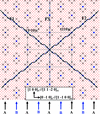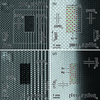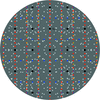issue contents
October 2014 issue

Cover illustration: Original experimental reciprocal space maps of total scattering from an InP(001) porous layer near the 004 node with pores oriented along the <111B> direction at azimuthal angle ![[varphi]](/logos/entities/phiv_rmgif.gif) = 0. Courtesy of Lomov et al. [J. Appl. Cryst. (2014), 47, 1614-1625].
= 0. Courtesy of Lomov et al. [J. Appl. Cryst. (2014), 47, 1614-1625].
research papers
Small-angle scattering spectra on casein micelles from milk are critically reviewed. Casein micelles from pooled milk can be described as spherical protein particles incorporating inhomogeneities, of a few nanometres, of protein and calcium phosphate clusters.
A rhombohedral analysis method for analysing the lattice distortion in a (111)-textured face-centred cubic film under rotationally symmetric stress is proposed and applied to ultra-thin Pt films deposited under argon–nitrogen atmosphere.
This work presents a hybrid immune–evolution strategy algorithm which is a combination of two methods of artificial intelligence – evolution strategies and an immune algorithm – with the classical method of Rosenbrock. The system can be successfully used for decomposition of the wide-angle X-ray diffraction curves of semicrystalline polymers into crystalline peaks and amorphous halos.
X-ray absorption spectroscopy (XAS) has been used to study the fine structure details of carbothermally reduced 3 mol% yttria-stabilized zirconia (YSZ) and understand the effect of sintering on various bond lengths in the starting powder and its sintered counterpart. The influence of ZrC formation on the YSZ matrix was determined with the help of X-ray diffraction and XAS. Bond lengths were deduced from the extended X-ray absorption spectroscopy pattern of the carbothermally reduced sample and compared with those of the pure standards.
The upgraded time-of-flight diffractometer SKAT the JINR in Dubna (Russia) is described. The reliability of texture analyses of polymineralic samples applying Rietveld texture analysis is evaluated.
The broadening of diffraction peak profiles of plastically deformed face-centred cubic and hexagonal close-packed alloys, and results of the Warren–Averbach method, are shown to be dependent on the measurement direction. Polycrystal plasticity models are used to show that these changes could be due to the heterogeneity of deformation, which results in differences in the types of dislocations and dislocation structures in different orientations, highlighting how errors can result from the use of an unweighted contrast factor.
The problem of removal of collimation distortion due to employing a slit collimation system in small-angle X-ray scattering experiments is considered for anisotropic objects. A mathematical statement of the problem is presented, and two approaches to `de-smear' the experimental scattering intensity are described. The described methods are applied to simulated and experimental data, and the results are discussed.
A structural model of nanosized cobalt is fitted to X-ray diffraction (XRD) data using the Debye equation. The model allows for shape, size distribution, atom pair distance distribution and stacking faults. Extended X-ray absorption fine-structure (EXAFS) and X-ray absorption near-edge structure (XANES) spectra are calculated on the basis of the fitted parameters.
The powder charge flipping algorithm has been applied to a variety of light-atom structures to test its limits, and a protocol for dealing with such structures is proposed.
Lignin-based carbon composite anodes consisting of nanocrystalline and amorphous domains are studied to develop a relationship of structural properties such as crystallite size, intracrystallite d spacing, crystalline volume fraction and composite density with their pair distribution functions, as obtained from both molecular dynamics simulation and neutron scattering.
The calibration of a high-energy diffractometer comprising a rotation axis and an area detector is assessed. An independent method for high-accuracy determination of the cell parameters of undeformed crystals is introduced.
Open  access
access
 access
accessThe time-dependent one-dimensional height profile of a standing surface acoustic wave on an LiNbO3 substrate has been reconstructed from stroboscopically recorded coherent grazing-incidence small-angle diffraction patterns.
Open  access
access
 access
accessThe nucleation and growth of niobium pentaethoxide-derived clusters in ethanol was monitored at 298–333 K by small-angle X-ray scattering. The data were analyzed with a newly derived model for polydisperse mass-fractal-like structures.
X-ray reciprocal space mapping was used for the investigation of porous InP layers. A new advanced statistical dynamical theory applied for numerical data evaluation provided quantitative values for the main structural parameters of the porous layers.
The crystal-chemical properties of clinker relicts within different types of aged cementitious materials were defined, integrating standard microstructural analysis by scanning electron microscopy with quantitative microchemical and micromineralogical analyses by electron microprobe and electron backscatter diffraction. The peculiar mineralogical, chemical and textural features observed raise interesting questions concerning the long-term hydration kinetics of clinker phases in operating conditions.
A novel experimental method to exploit specular neutron reflection from the surface of mica at the solid/liquid interface is reported. The approach involves supporting a thin mica crystal on a silicon substrate. The applicability of this technique for mica is demonstrated by adsorption of a dichain surfactant to form a complete unhydrated bilayer at this interface and its partial removal by washing and ion exchange.
A crossover from orthorhombic to tetragonal structure is investigated for (Ba0.92Ca0.08)(Zr0.05Ti0.95)O3 using temperature-dependent X-ray diffraction.
It is shown that calculations of the coherent diffraction from nanocrystals, suitably averaged over a full range of possible orientations, give coherent diffraction profiles that resemble those of measured biogenic and synthetic amorphous calcium carbonate data when the nanocrystallite size is of the order of 1.0 nm.
Soft X-ray back-diffraction (XBD) is explored in an ultra-thin Si(220) crystal. Extreme XBD measurements show close agreement with theory, opening up new possibilities in X-ray optics.
A search is undertaken for the unique axes of rotation in clusters using tensor of inertia calculations. The case of BH4 clusters in magnesium borohydride is used for illustration.
The morphology and interfacial structure of the ∊′-Mg54Ag17 precipitates in an Mg–Sn–Mn–Ag–Zn alloy have been studied both experimentally by transmission electron microscopy and theoretically using a secondary coincident site lattice model. The good agreement between the experimental results and theoretical calculations implies the preferred rules of the precipitates' crystallographic features.
Extensive studies of the projected local structure of PZTmpb by the techniques of high-angle annular dark-field and annular bright-field imaging have revealed displacements on B sites as well as extensive distortions and possibly rotations of the oxygen cages.
Scanning electron microscopy generated, digitally recorded Kossel patterns originating from crystallites of arbitrary orientation can be used for local strain determination. The experimental setup is described, and the strain resolution of the technique is estimated.
It is shown experimentally that diffraction peaks which are normally obscured by fluorescence peaks in energy-dispersive X-ray diffraction can be revealed by tuning of the X-ray tube excitation voltage in order to suppress the fluorescence peaks.
The principles of continuous multiple-beam diffraction occurring within special crystallographic planes of cubic structures and the procedure to determine such planes are illustrated for optimization of X-ray monochromator designs and for general X-ray multiple-beam diffraction characterization of cubic structure crystals.
A detailed extended X-ray absorption fine structure (EXAFS) analysis on Fe–Pt–Cu thin films as a function of Cu concentration has been carried out at the Cu K and Pt LIII edges by using linear dichroism. The study allowed the determination of the effects of chemical ordering and lattice distortion in the L10 structure, which strongly affect the magnetic behaviour of the alloy and its technological application.
Free 

The crystallographic orientation relationships of precipitated β-Mg2Sn particles in Mg–9.76 wt% Sn alloy aged at 573 K for 5 h were investigated by advanced transmission electron microscopy (TEM). Models of the interface of precipitated β-Mg2Sn and the α-Mg matrix were constructed via high-resolution TEM and atomic resolution high-angle annular dark-field scanning TEM.
A complete survey regarding rotational variants associated with metastable (η′) and equilibrium (η) precipitate crystals in an Al–Mg–Zn alloy has been undertaken. The subject of superimposed reciprocal lattices has been treated in great detail.
Free 

A new custom-built and highly flexible small-angle X-ray scattering instrument is presented.
Iron oxide nanoparticles concomitantly show size-driven expansion and oxidation-driven contraction. These effects influence the accuracy of lattice parameter and stoichiometry determination, which are quantitatively assessed in the frame of the total scattering Debye function analysis.
short communications
Deposition of a thick film of carbon fibers proved to be an effective method to bend two 5 mm-thick Si monocrystals. High diffraction efficiency was recorded with a 150 keV X-ray beam.
The design of an optical chopper and chopper housing for in-house time-resolved photocrystallography of short-lived species is described. The chopper is capable of generating X-ray pulses down to time lengths of about 5 µs.
The article describes an angle calculation procedure for the reduction of a two-dimensional powder diffraction pattern registered with an area detector rotated off the incident beam axis by the two orthogonal detector rotations of a pseudo-six-circle diffractometer.
computer programs
A freely available program dedicated to the identification of nonbonded interactions in small molecules as well as biomolecules is introduced. The standalone version of the program is currently available for download. The web server can be accessed at https://nucleix.mbu.iisc.ernet.in/molbridge/index.php.
A command-line program is presented to generate Shishkin's energy-vector models from the results of Gavezzotti's PIXEL calculations. The output models permit convenient visualization of the intermolecular interaction topology.
Open  access
access
 access
accessAn iOS app has been developed as a front end to ISPyB, a laboratory information system for macromolecular crystallography synchrotron beamlines.
The freely available open-source GSAS-II package now contains modules for the analysis of small angle X-ray scattering data. This includes processing of two-dimensional images to create one-dimensional patterns, analysis of the size distribution and modelling of the one-dimensional data with a combination of various scattering components, and slit smearing corrections can be applied where needed.
A program to extract coordination numbers, atomic separations and disorder parameters from neutron and X-ray pair-distribution functions is described. The application of this program in the analysis of data from a melt-quenched (Na2O)0.5(P2O5)0.5 glass and a (TiO2)0.18(SiO2)0.82 sol–gel is presented.
Open  access
access
 access
accessDPDAK is a software for simple and fast on- and offline reduction and analysis of X-ray scattering data. It is an open-source software with a plug-in structure allowing tailored extensions.
laboratory notes
Bushings that protect the plunger in a repeat dispenser device for more effective setting up of lipid cubic phase crystallization trials are described.


 journal menu
journal menu


























































